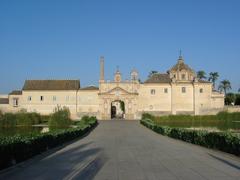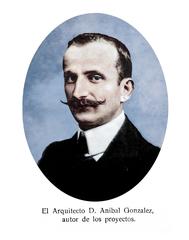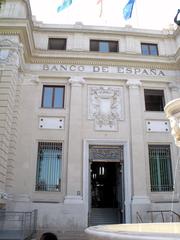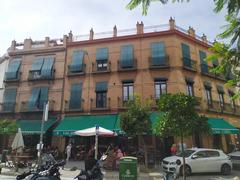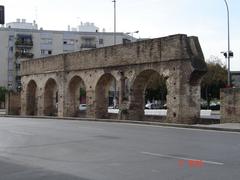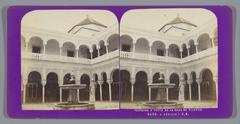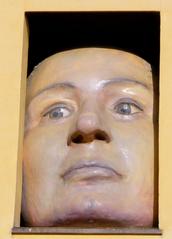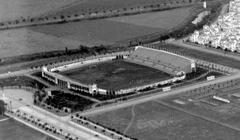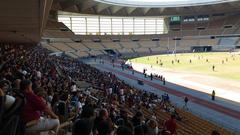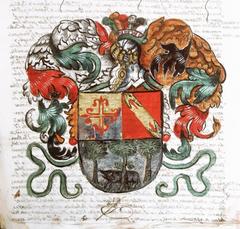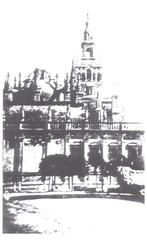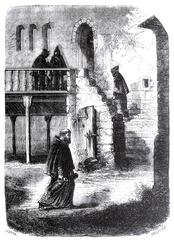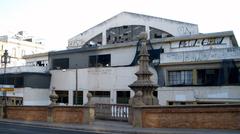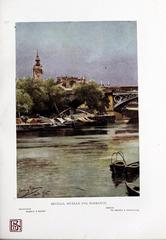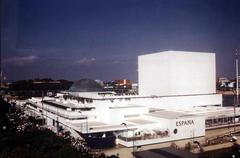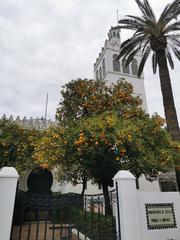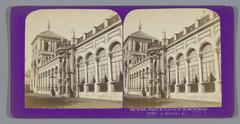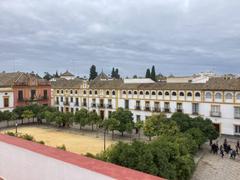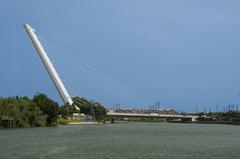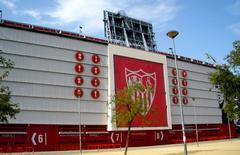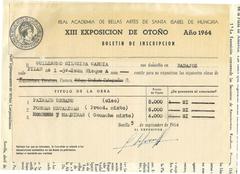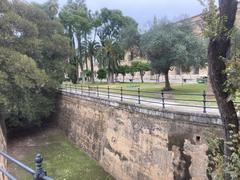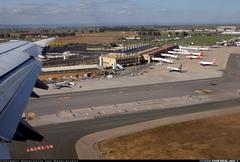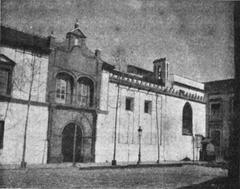Antiguo Monasterio De La Cartuja De Santa María De Las Cuevas
Antiguo Monasterio De La Cartuja De Santa María De Las Cuevas: Visiting Hours, Tickets, and History in Seville
Date: 14/06/2025
Introduction
The Antiguo Monasterio De La Cartuja De Santa María De Las Cuevas—commonly called La Cartuja—is one of Seville’s most significant and evocative historical sites. Situated on the tranquil Isla de la Cartuja along the Guadalquivir River, this former Carthusian monastery traces a fascinating trajectory from medieval sanctuary through Renaissance patronage, Napoleonic turmoil, industrial transformation, and, today, as the vibrant home of the Centro Andaluz de Arte Contemporáneo (CAAC). Its architecture is a rich tapestry, blending Gothic, Mudéjar, Renaissance, and Baroque styles, while its legacy encompasses pivotal moments in Andalusian and global history, including its ties to Christopher Columbus and the Age of Discovery. Thorough restorations in the late 20th century have preserved its layered past and ensured its ongoing cultural vitality.
This guide presents a comprehensive overview of La Cartuja’s history, architectural evolution, and current role as a cultural hub, along with all practical information for visitors, including opening hours, ticket options, accessibility, and tips for making the most of your visit. For detailed updates, always refer to the Centro Andaluz de Arte Contemporáneo official website and Andalucía Tourism.
Table of Contents
- Introduction
- Historical Overview and Evolution
- Architectural and Artistic Highlights
- Visiting La Cartuja: Practical Information
- The Centro Andaluz de Arte Contemporáneo (CAAC)
- Cultural Impact and Legacy
- Frequently Asked Questions (FAQ)
- Conclusion
- References and Further Reading
Historical Overview and Evolution
Early Origins and Medieval Foundations
La Cartuja’s origins date to the 12th century, when the Almohads exploited the rich clays of the area for ceramics production, laying early industrial roots. By the 13th century, a local legend tells of the discovery of a hidden image of the Virgin Mary in a cave, prompting the creation of a Franciscan hermitage. In 1400, Archbishop Gonzalo de Mena y Roelas established the Carthusian monastery, marking the beginning of a contemplative religious community whose influence would shape the site’s austere but elegant architectural ethos.
Architectural Development: Gothic, Mudéjar, Renaissance, Baroque
The monastery’s construction unfolded over centuries, beginning with late Gothic structures—pointed arches, ribbed vaults, and brickwork typical of Andalusian Gothic (Patrimonio Histórico de Andalucía). Over time, Renaissance and Mannerist features appeared, such as classical arcades and coffered ceilings, followed by Baroque flourishes in ornate chapels and gilded altars (Sevilla City Council). Mudéjar decorative elements, including glazed tiles and intricate wooden ceilings, reflect the enduring dialogue between Christian and Islamic arts in Andalusia (Andalucía.org).
The Columbus Connection and Renaissance Patronage
La Cartuja played a unique role during the Age of Discovery. Christopher Columbus sought spiritual retreat and support here, using the monastery’s library and patronage networks in preparing his voyages. His remains were interred at the site for decades, highlighting the monastery’s significance in both religious and exploration history. The Renaissance era saw further enrichment through donations from noble families such as the Ribera.
Monastic Decline and Industrial Transformation
The 19th century brought tumult: Napoleonic occupation, the expulsion of monks during the Desamortización de Mendizábal, and secularization. In 1841, the site’s fate changed dramatically when Charles Pickman converted it into a ceramics factory, adapting the monastic spaces to industrial uses and constructing distinctive bottle-shaped kilns that still define the skyline (Patrimonio Industrial de Andalucía). This blend of sacred and industrial architecture is rare in Spain.
Restoration, Expo ’92, and Contemporary Rebirth
Following the cessation of factory operations in the late 20th century, La Cartuja underwent major restoration. Declared a national monument in 1964, it played a central role during Seville’s Expo ’92, serving as the Royal Pavilion and an exhibition hub. These efforts preserved its historical fabric and positioned it for new cultural uses (Nomads Travel Guide).
Modern Use: Cultural and Artistic Center
Since 1997, La Cartuja has been home to the Centro Andaluz de Arte Contemporáneo (CAAC), making it a leading venue for contemporary art in southern Spain. The site also houses the rectorate of the Universidad Internacional de Andalucía. Its calendar features exhibitions, concerts, educational programs, and community events, all within a setting that fuses historic ambiance with creative innovation.
Architectural and Artistic Highlights
Key Features
- Gothic Foundations: The church nave and chapels showcase pointed arches, ribbed vaults, and austere stonework (Patrimonio Histórico de Andalucía).
- Renaissance and Mannerist Additions: Elegant arcades, classical proportions, and coffered ceilings in the Claustro de los Muertos and sacristy (Sevilla City Council).
- Baroque Flourishes: Ornate chapels like the Capilla de Santa Ana feature gilded altars and dynamic sculpture (Museo de Arte Contemporáneo de Sevilla).
- Mudéjar Influences: Glazed tiles (azulejos), horseshoe arches, and wooden ceilings enrich numerous spaces, reflecting local craftsmanship (Andalucía.org).
- Industrial Heritage: The Pickman era added brick kilns, warehouses, and chimneys that now stand alongside monastic spaces (Patrimonio Industrial de Andalucía).
Sculptures, Altarpieces, and Decorative Arts
The site’s artistic heritage includes late Gothic funerary monuments, notably the tomb of benefactor Gonzalo Fernández de Córdoba, as well as mural fragments and contemporary art installations. The decorative program extends to beautifully preserved tiles and ceramics, a legacy of the Pickman factory (Andalucía.org).
Cloisters, Gardens, and Spatial Organization
The complex features several cloisters—most notably the Claustro Grande and atmospheric Claustro de los Muertos—surrounded by arcaded galleries and cypress trees (Patrimonio Histórico de Andalucía). Restored gardens with Islamic-inspired water channels and fountains integrate greenery and tranquility into the architectural ensemble (Sevilla City Council).
Visiting La Cartuja: Practical Information
Visiting Hours
- Tuesday to Saturday: 11:00 AM – 7:00 PM
- Sunday: 11:00 AM – 3:00 PM
- Monday: Closed
- Note: Hours may vary on holidays or for special events. Always check the official CAAC website before your visit.
Ticket Prices
- General Admission: €5
- Reduced (students, seniors): €3
- Free Entry: Children under 12, residents of Seville (with ID), and Sundays after 3:00 PM
- Guided Tours: Available for an additional fee; advance booking recommended
- Tickets can be purchased online or at the entrance.
Accessibility
- Wheelchair access is available for main areas, with ramps and elevators where possible.
- Accessible restrooms and assistance available upon request.
Guided Tours and Audio Guides
- Guided tours (in Spanish/English) provide detailed insight into La Cartuja’s history and art.
- Audio guides are available in multiple languages.
Directions and Transportation
- Public Transport: Bus lines C1, C2, 3, 6, and 40 serve the area.
- Taxi: About 15 minutes from Seville city center.
- Parking: Limited spaces nearby.
- Address: Avenida Américo Vespucio, 2, 41092 Sevilla, Spain
- For routes and schedules, see Tussam Seville Transport.
Nearby Attractions
- Isla de la Cartuja parks and gardens
- Seville Aquarium
- Plaza de España
- Isla Mágica Theme Park
- Pavilion of Navigation (Pabellón de la Navegación)
Events and Exhibitions
The CAAC hosts rotating exhibitions, concerts, lectures, and open-air events throughout the year. Major exhibitions often feature international artists. Some events require separate tickets or advance booking (CAAC Events Calendar).
Visitor Tips
- Wear comfortable footwear—the site covers over 60,000 square meters with uneven surfaces.
- In summer, bring sun protection and water; temperatures can be high.
- Photography is allowed in most areas, but flash and tripods are prohibited.
- Respect quiet zones in chapels and cloisters.
The Centro Andaluz de Arte Contemporáneo (CAAC)
Mission and Collection
The CAAC is Andalusia’s premier institution for contemporary art, with a mission to collect, research, and promote regional, national, and international art from the mid-20th century onward. Its permanent collection numbers over 3,200 works—including painting, sculpture, photography, video, and installations (WhichMuseum).
Cultural Engagement and Community Involvement
The CAAC organizes seminars, workshops, concerts, film cycles, and community events, fostering dialogue between artists, scholars, and the public. During summer, the monastery gardens host open-air concerts and cultural programs (Nomads Travel Guide). In 2025, the CAAC formalized a Technical Commission to guide its strategic direction (Artepuntoes).
Visiting Hours
- Tuesday to Saturday: 11:00 AM – 9:00 PM
- Sunday: 11:00 AM – 3:00 PM
- Closed Mondays
- Public Holidays: 10:00 AM – 3:30 PM
- Closed on January 1 and 6, February 29, May 1 and 2, August 15, December 24, 25, 26, and 31 (WhichMuseum).
Tickets
- Monument or temporary exhibitions: €1.80
- Full visit: €3.01
- Free entry:
- Tuesday–Friday, 7:00–9:00 PM
- Saturdays, 11:00 AM–9:00 PM
Accessibility
- Wheelchair access to most areas.
- Some historic sections have limited access.
- Contact the museum in advance for accommodations.
Highlights and Experiences
- Explore the monastery’s grand entrance, domed church, cloisters, and refectory.
- Stroll through gardens and patios with river views.
- Enjoy temporary exhibitions by prominent international and Andalusian artists (Plataforma de Arte Contemporáneo).
- Take part in guided tours and attend open-air events.
Cultural Impact and Legacy
- Historical Significance: Once a major religious center, La Cartuja was crucial during the Age of Discovery and is linked to Christopher Columbus (Andalucia.com).
- Industrial Heritage: The ceramics factory phase contributed to Seville’s global reputation for earthenware (Cerámica de la Cartuja).
- Contemporary Influence: The CAAC bridges Andalusia’s heritage with global contemporary art trends (CAAC Mission).
- Community Engagement: Educational programs and public events connect the site with local and international audiences, making it a living monument.
Frequently Asked Questions (FAQ)
Q: What are the visiting hours?
A: Generally Tuesday–Saturday 11:00–19:00, Sunday 11:00–15:00. Check CAAC Official Website for seasonal updates.
Q: How do I buy tickets?
A: Online via the CAAC website or at the entrance. Free entry available at certain times.
Q: Is the site accessible?
A: Most main areas are wheelchair accessible; some historic zones have steps.
Q: Are guided tours available?
A: Yes, in Spanish and English. Book in advance for the best availability.
Q: Can I take photographs?
A: Yes, except in some special exhibitions; flash and tripods are not allowed.
Q: What other attractions are nearby?
A: Triana district, Aquarium, Isla Mágica Theme Park, and the Pabellón de la Navegación.
Conclusion
The Antiguo Monasterio De La Cartuja De Santa María De Las Cuevas is a living testament to Seville’s evolving identity—melding monastic heritage, industrial legacy, and cutting-edge contemporary art. With accessible hours, affordable tickets, and a vibrant calendar of events, La Cartuja is an essential stop for any visitor to Seville. Plan ahead, explore its serene cloisters, historic kilns, and modern galleries, and immerse yourself in the dynamic dialogue between past and present.
For further details, always refer to the official CAAC website and consider downloading the Audiala app for guided tours and insider tips.
References and Further Reading
- La Cartuja Monastery in Seville: Visiting Hours, Tickets, and Historical Guide, 2025
- Visiting La Cartuja: Hours, Tickets, and Historical Highlights of Seville’s Iconic Monastery, 2025
- Visiting the Centro Andaluz de Arte Contemporáneo (CAAC): Hours, Tickets, and Seville Historical Sites, 2025
- Visiting the Antiguo Monasterio De La Cartuja De Santa María De Las Cuevas: Hours, Tickets, Accessibility, and Cultural Highlights in Seville, 2025
- Andalucía Tourism Official Site, 2025
- Patrimonio Histórico de Andalucía, 2025
- Sevilla City Council Cultural Heritage, 2025
- Plataforma de Arte Contemporáneo, 2025
- Nomads Travel Guide, 2025
- Spanish Ministry of Culture, 2025
- Cerámica de la Cartuja, 2025
